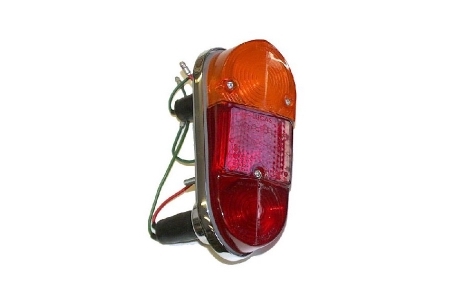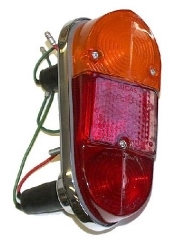Upgrade Your MG Using Brittrix LED Lights


Troubleshooting Your LED Installation
Lew Palmer, Brittrix, Ltd.
Website: https://www.brittrix.com/
So you have purchased LED light boards and they don’t work as expected. What has gone wrong?
Selling LED conversion light boards for over 350 different British vehicles, one tends to see almost every possible problem. Although each different model has been carefully designed, built, and tested before they are shipped, the variations in the wiring of the various vehicles, the condition of the wiring in those vehicles, and the skill and experience of the owner/installer, can lead to some pretty bizarre results. Most installations are without drama – they work perfectly with no strange behavior. However, due to the fact that LEDs draw a very small current when working perfectly, a small amount of current going to the wrong place can lead to failure.
So what are the most common problems? Let’s start with the obvious.
Flasher: The turn signal flasher originally installed in our cars were an electro-mechanical device. These depended upon the use of incandescent bulbs. The average 1157 bulb draws over 2 amperes. The flasher used a bi-metallic strip which bends and breaks the circuit when the current draw heats up that strip. Then when the circuit is interrupted, the strip cools and straightens thus reconnecting the circuit. This repeats thus creating the on-off flashing. The LED boards only draw around one tenth of the current which is simply not enough to trigger the flasher. Some flashers are designed to think that a bulb has burned out when the current draw is so low. Their typical reaction is to flash at a much higher rate, so the LEDs start flashing at that rate. Usually, if you still use incandescent bulbs in the front turn signals and only use LEDs at the rear, in most cases there is still enough current drawn to allow the old style flashers to work.
But if that proves not to be the case, or you have LEDs front and back, the solution is to use a flasher designed to work with LEDs. Not all LED flashers are created equal. There are several good ones that have proven to work well. Among these are the Tridon CF13, and any of the flashers from LiteZupp. Be careful, however, as many of the flashers are polarity sensitive, meaning you have to follow the installation instructions carefully.
LEDs don’t work at all: LEDs are not dimmable. In other words, if the supply voltage is sufficient, they work at full intensity. But if the supply voltage is low, they simply don’t light. Often a low voltage or bad connection is the cause of the problem
If at all possible purchase or borrow a multimeter with both voltage and resistance scales.. An analog multimeter (moving coil) variety is best. Digital meters be subject to the electrical noise from your ignition or generator and can give false or unsteady readings.
Check the voltage supplied to each of the LED boards. If lower than 12 volts (and no higher than 14.5 volts) check for a dirty or loose connection somewhere in the lighting circuit. Make sure the wires going to the LED board are secure.
Ensure that you have LED boards that match the polarity of your vehicle. Many, but not all of our new designs are polarity neutral, meaning they will work in either a positive or negative ground car.
Check for and disconnect any heavy current consuming device such as a halogen 3rd brake light.
Turn signals flash too fast: see comment in Flasher section.
Turn signals flash too slow or not at all: This can be low voltage at the LED board. Check that the supply voltage at the board is between 12 and 14.5 volts. Also see that you are using a LED appropriate flasher.
Flashers only work when the engine is off: LED light boards and LED flashers are electronic circuits that operate on very low current. Therefore, they can be sensitive to electromagnetic interference (EMI). The ignition in our cars is quite the opposite. They operate on very high voltages. The repeated pulses of high voltage from your car’s ignition can cause enough EMI to confuse the LEDs or the flasher. The solution is to ensure the LED flasher is shielded in a metal can and that can is grounded to the body. Also connect a condenser between the X (power in) terminal on the flasher and a good ground point (such as the flasher mounting point. A spare distributor condenser is ideal.
Both turn signals flash (even weakly) when only one turn signal is selected: This is likely voltage leak through the dash indicator. Remove the dash indicator bulb and see if that cures the problem. If it does, contact us. We may be able to help with a special add-on device.
This can also be caused by incorrect wiring of an incandescent turn signal bulb. If the wires to a bulb have been reversed such that the hot wire goes to the bulb shell and the ground wire goes to the center contact, a ground return path can be established. This can lead to supply voltage being fed to unexpected places. An incandescent bulb doesn’t care which way the current flows, but an LED board does.
If you have a set of our boards and the installation hasn’t gone the way you expected and these steps haven’t helped, don’t hesitate to get in touch. The most expedient way to get in touch is through out web site or via email.
We have constantly been designing and building new LED lamp conversions and updating earlier designs, so come back and visit our web site often. If you haven’t yet upgraded to our LED lighting. do consider it. There is simply no comparison in brilliance between incandescent bulbs or LED bulbs versus our LED boards. Some of our boards are up to 10 times brighter than the alternatives. They cost a bit more, but far less than a rear end collision.
Lew Palmer
Brittrix, Ltd.
sales@brittrix.com
a href=”https://www.brittrix.com/” rel=”noopener” target=”_blank”>www.brittrix.com

